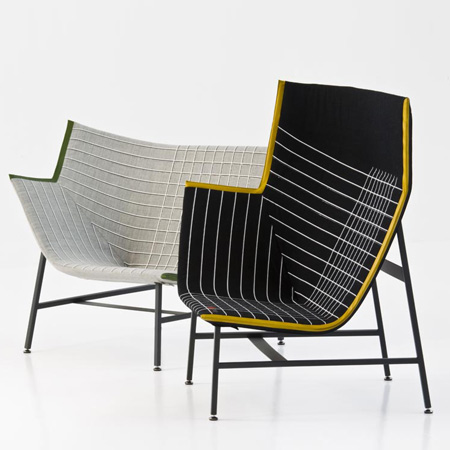
9 X 10: Swarovski Elements at Work
Milan 2010: these chairs embellished with crystals by London designers Doshi Levien are among work by designers including Nendo, Konstantin Grcic and Neri & Hu, commissioned by Swarovski Elements and presented in Milan this week.
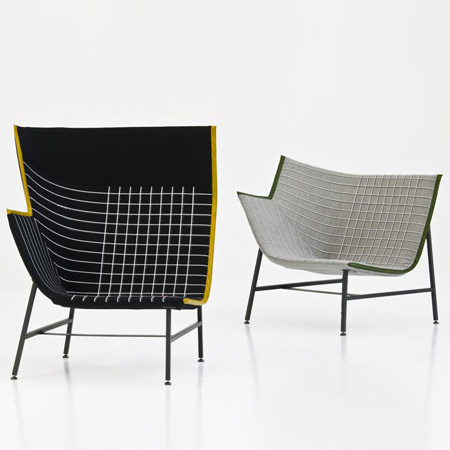
Called 9 X 10: Swarovski Elements at Work, the collection pairs ten designers with nine manufacturers, including Moroso, Quinze & Milan and BD Barcelona Design.
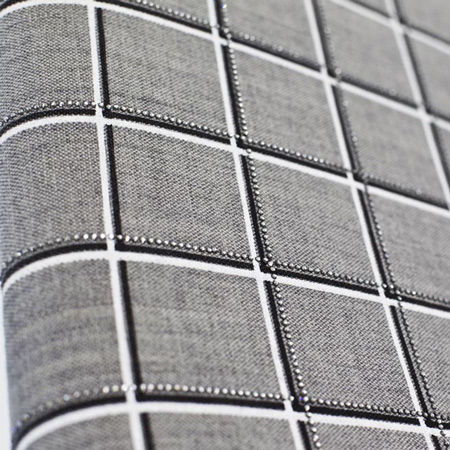
Captions are provided by Swarovski Crystal Palace. See all our stories about Milan 2010 in our special category.
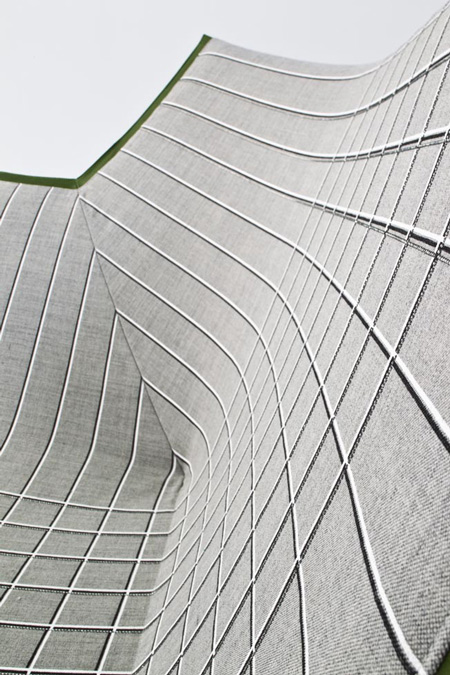
Top and Above: Doshi Levien for MOROSO: Paper Planes - crystals with upholstery. Jonathan Levien and Nipa Doshi are a life/work couple based in London who met while studying at the Royal College of Art. Their relationship with MOROSO dates back to 2007; for the Italian company they have created a range of products demonstrating her love of textiles and pattern and his rigorous approach to design. For SWAROVSKI ELEMENTS at Work they have designed a small armchair that’s perfect for reading or relaxing, upholstered in a bespoke fabric using crystal. “The brief for this project was to create a usable product, so we had to make sure the crystal had some function and didn’t overwhelm the whole piece. We designed a highly geometric checked fabric where the crystal forms one of the lines. It becomes a fine, repeated detail rather than a massive statement,” says Doshi. “In material terms, the wool fabric is light-absorbent and the crystal reflective. It was important to play with that contrast,” adds Levien.
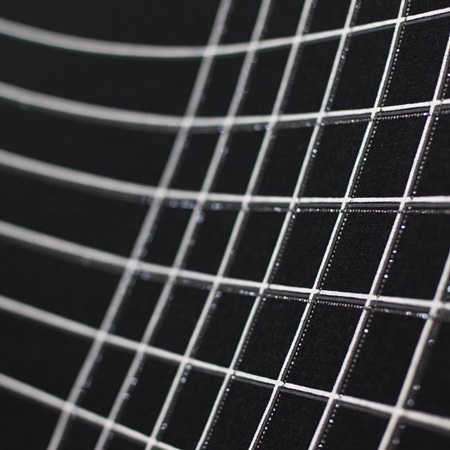
MOROSO is known as one of Italy’s most imaginative furniture producers and works extensively with Ron Arad, Patricia Urquiola, Tokujin Yoshioka and Tord Boontje among others. Patrizia Moroso, the company’s creative director, says of Doshi Levien: “Their work is really new in the way that it so successfully mixes tradition and modernity.”
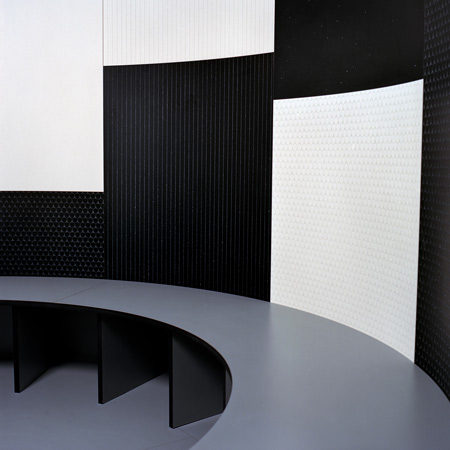
Above: Konstantin Grcic for ABET LAMINATI: Crystaline collection - crystals with laminate. The renowned industrial designer Konstantin Grcic, who is based in Munich, has created three new designs (Ray, Peak and Bling) for ABET LAMINATI, the Italian laminate specialists using for the first time ever crystals on laminate, something not previously attempted. “The project brief was to link crystal with the furniture industry, so I thought it would be best to create a material, rather than a product.
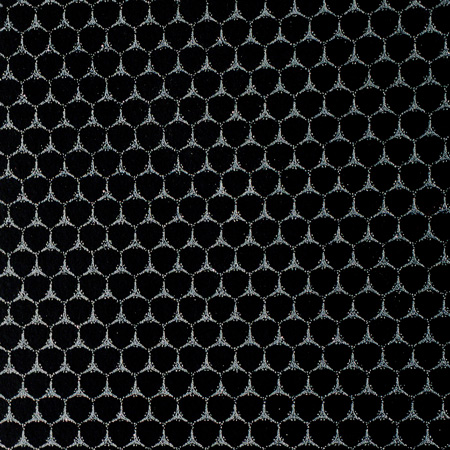
Something that can be applied to furniture and interiors,” says Grcic. “Two of the patterns are very geometric, and all three use crystals sparingly. The effect of the crystals is so strong that a few seemed to look more precious than many.” Grcic has designed a bespoke circular seating area to demonstrate the new laminate, which will be seen exclusively in Milan at the Triennale.
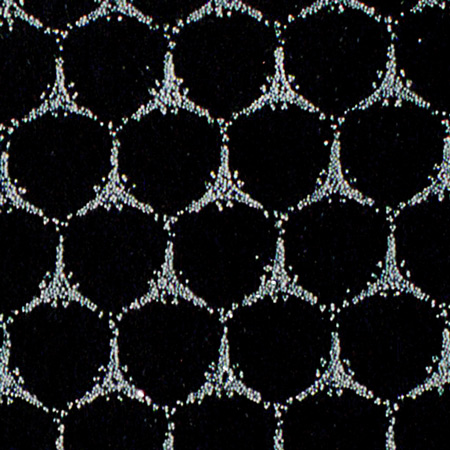
ABET LAMINATI was established in 1957 and has an unparalleled reputation for innovation. Recently it has carried out extensive research into digital printing, high gloss finishes and a translucent laminate. It has an archive bursting with celebrated designer names including Ettore Sottsass, Alessandro Mendini and Joe Colombo. Grcic now joins them. “We were able to find a way to create a completely new material,” says ABET LAMINATI’s marketing director Alessandro Peisino. “Laminate is paper impregnated with resin and compressed with 90kg of pressure per square centimetre. We had to create a special compression system in order to integrate, and not crush, the crystal. Konstantin made his design succeed within the limits of our technology – that’s the mind of a true industrial designer at work.”
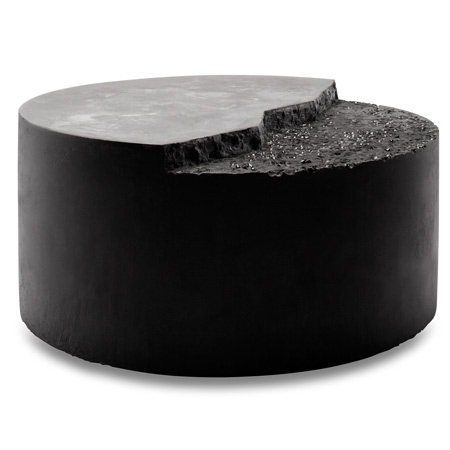
Above and below: Gitta Gschwendtner for Quinze & Milan: Quarry and Soft Crystal Series - crystals with plaster and ceramic; crystals with silicon. Gitta Gschwendtner came to London from Germany in the early 1990s to study furniture design, and stayed. “What was important to me was to make something which challenged the application of the crystals,” she says of the project.
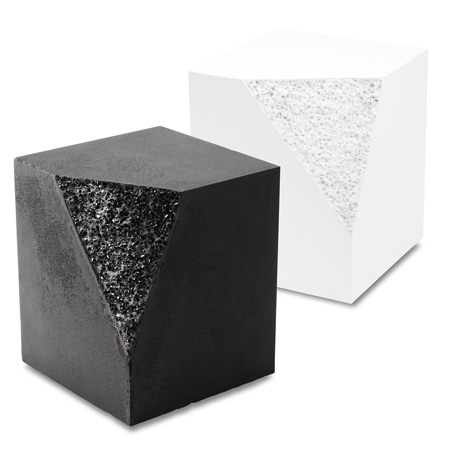
“They had to be entirely integrated into the piece.” Her two solutions were to cast a plaster and resin mix as stools and a low table, with a broken away, but crystal-sprinkled corner; and to encrust a soft silicon vase completely in crystal.
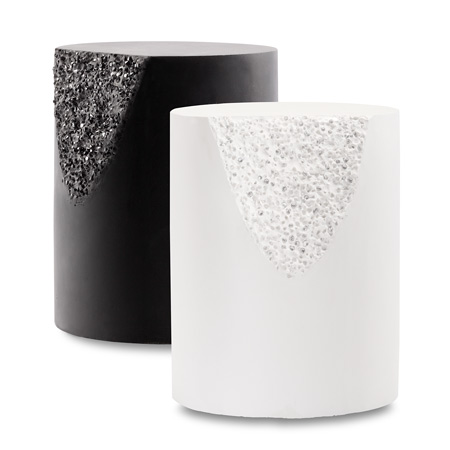
“I love the way the crystals are so highly engineered and precise and perfect but appear in the imperfect moment of the broken corner,” she says.
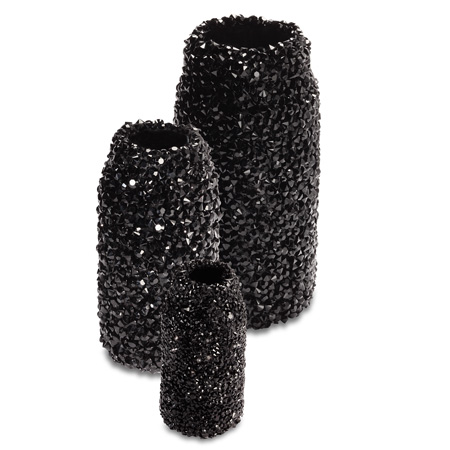
“For the vases, the crystals are randomly set, so you get to see all sides, the highly polished face and the matte sides also. It’s rugged and strong, so it’s a shock when you pick it up and it squashes in your hand.”
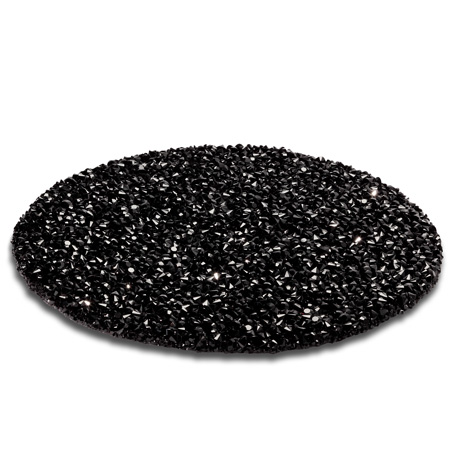
Lionel Doyen is head of design at the Belgian company Quinze & Milan. “It’s not easy to introduce crystal into our kind of work on the one hand. On the other, it is our aim to push the borders and make the unexpected. That aspect of the collaboration was important to us. I really think both products will surprise people,” says Doyen.
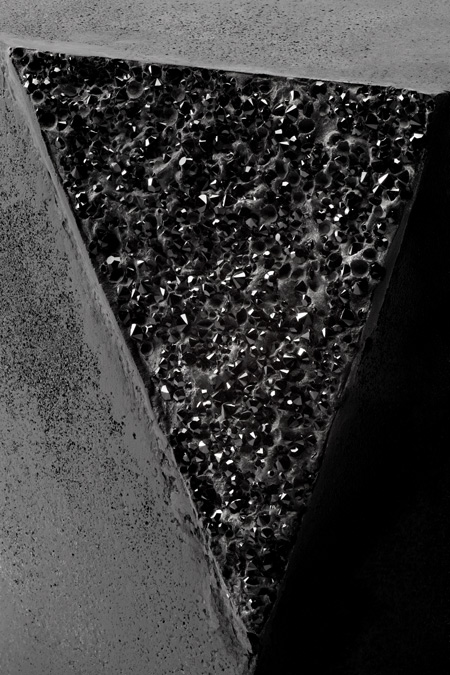
“For the stools we needed something that would be easy to cast, but heavy enough to have a sharp edge. The plaster/resin – which has the name Keramic – turned out to be the right material. And because you don’t fire it, it stays soft to the touch.”
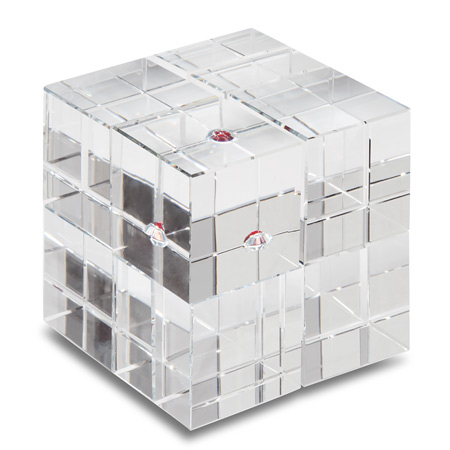
Above and below: Nendo for GAIA&GINO: Puzzle collection - crystals with glass
Through sheer inventiveness and an economy of means, Nendo has become one of the most formidable design voices to emerge from Japan. For Oki Sato, the firm's principal,working with Swarovski meant encouraging users to “experience a process that allows them an even deeper understanding of the beauty of crystals." Nendo’s Puzzle collection for Gaia&Gino is created by making repeated linear cuts into a cube of glass. Just visible inside the resulting glass blocks is a single Swarovski crystal that further reveals itself as the user takes the puzzle apart. “People can retrace the process of the crystal’s creation, allowing the sparkling gem to emerge,” Sato says.
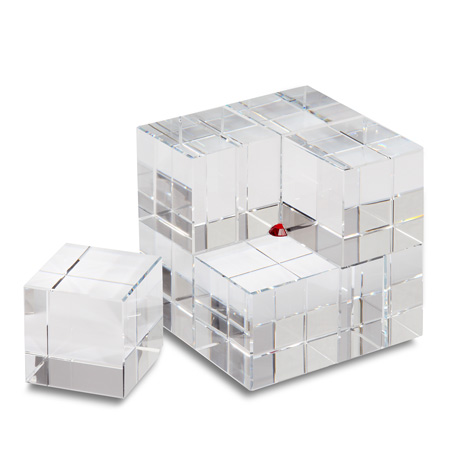
Working with Nendo has represented a major departure for Gaye Cevikel in several ways. “They are very creative and conceptual,” says Cevikel. “So the ideas come first and the commercialisation of them has been another stage. We have ended up making GAIA&GINO’s first non-functional product, but it’s a thing of great beauty and it’s also fun, which fits with the GAIA&GINO agenda. People will find the crystal in the middle of the glass cubes like a hidden jewel. It’s about reactions and play.”
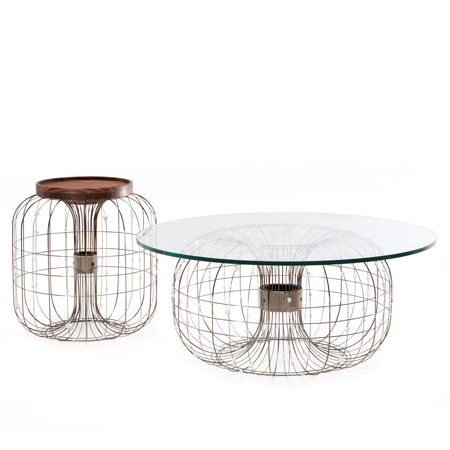
Above: Neri & Hu for MERITALIA: un-WIRED collection - crystals with metal. How can one capture both the solid and ephemeral qualities of crystal in a single piece of furniture? For Lyndon Neri and Rossana Hu of Shanghai’s neri&hu, the answer lies in the un-WIRED collection. Designed in small, medium and large sizes, its base is made of blackened stainless steel wires that form a thin lacing structure on which crystal beads are threaded. The table tops come in colored glass or wood. “This collection glorifies the natural brilliance of crystals, while almost de-materializing the wire supporting structure on which the table tops rest,” says Hu. Adds Neri: “In the dark, the blackened wire fades into the background, making it seem as if the crystals are floating in air.”
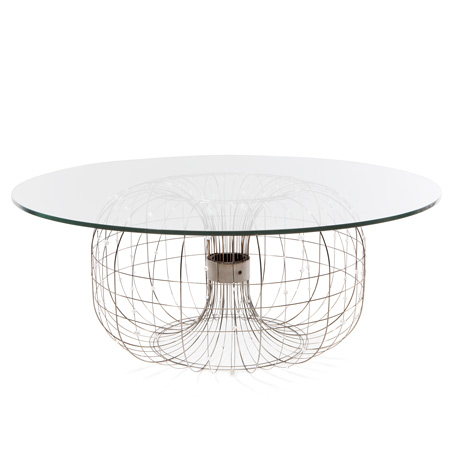
The company President Mr. Giulio Meroni founded MERITALIA in 1987 for the production of upholstered and other furnishing elements that combine design, craftsmanship and the latest technology. Since then, the company has developed a precious know-how that today allows it to reach the highest standards of quality, marrying the creativity of important designers who have so far included Mario Bellini, Alessandro Mendini, Marc Newson, Fabio Novembre, Gaetano Pesce, Karim Rashid, and others—with the technique, care, ability and experience gained from decades in the field. Meritalia specializes in upholstered furniture, but partners with other factories within the Meritalia group such as Mele, which focuses on woodwork, and Meme, with its expertise in metal.
SWAROVSKI ELEMENTS at Work has provided Meritalia the opportunity to establish its first Chinese-based designer partnership, with Lyndon Neri and Rossana Hu of Shanghai’s neri&hu. Of the Un-WIRED collection of tables that have resulted, Meroni says: “I like the concept very much. When you put these tables into a darkened space, it looks like the crystals are suspended in air. They are not just there to enrich the piece – it’s like they’re floating. With the glass tops in a range of different colours – green, yellow, red – this is a design full of surprise, craft and beauty.”
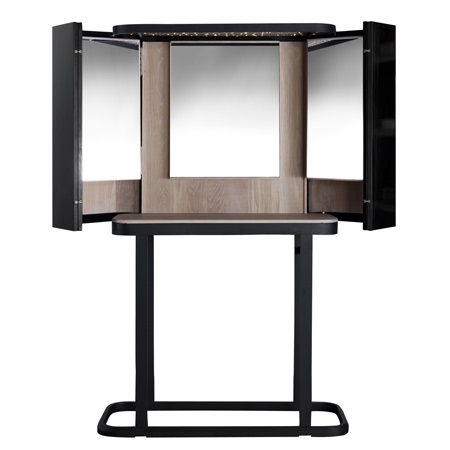
Above: Neri & Hu for BD Barcelona Design: The Narcissist collection - crystals with wood. For Spain’s BD Barcelona Design, the innovative Shanghai-based firm neri&hu has offered a new take on a cross-cultural furniture typology known in Spanish as the Tocador and, in Mandarin, as the Shu Zhuang Tai. The lacquered Narcissist Tocador is a dressing table with a clean, simple storage chest that opens to three folding mirrors and is topped with a crystal-set lattice. The latter references the atomic structure of crystals while recalling a popular traditional Chinese furniture motif. “It not only evokes the repeating pattern of crystal formation, but also articulates a brilliant configuration of light and shimmer for the person seeing his or her own image in the mirror,” says neri&hu co-founder Rossana Hu. world.”
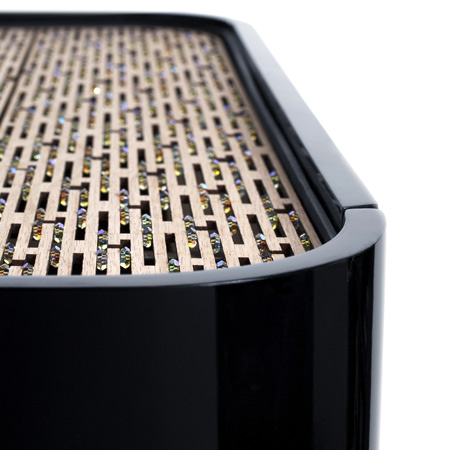
Alongside a matching stool, the Narcissist collection is accompanied by a round wall mirror and a jewelry case shaped like an historic Chinese dowry box. In the former, crystals set into the underside of the mirror’s rim form a galaxy of tiny stars, while the latter sees them incorporated in a pattern of stitches, visible when the jewelry box is opened and the crystals are barely discernible through the semi-transparent mirror of the inside cover. “For each design, we wanted to utilize a different application of crystals, finding new ways to emphasize and bring out their intrinsic, visual qualities,” says Lyndon Neri, the other half of the husband-and-wife team.
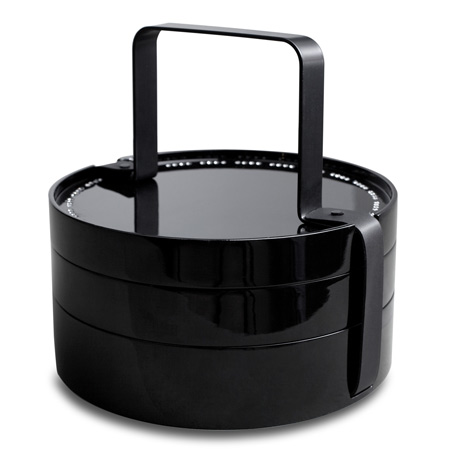
Founded in 1972 as Bd Ediciones de Diseño, BD Barcelona Design is Spain’s leading design manufacturer. With designers including Ettore Sottsass, Alvaro Siza, Ross Lovegrove, Konstantin Grcic and Jaime Hayon among its collaborators, the company continues to produce award-winning work that inspires. For general manager Jordi Arnau, it was only natural to add neri&hu to its roster. “We have worked together with Lyndon and Rossana for more than five years, as customers of BD Barcelona Design,” he says, referring to the retail operation Design Republic, run by the pair in Shanghai. “But it was only very recently that we learned of their work as designers, and we were astonished by what we saw.” Adds Arnau: “They combine very well the tradition of Chinese craftsmanship with modern design, creating a new language for objects that is very unique around the
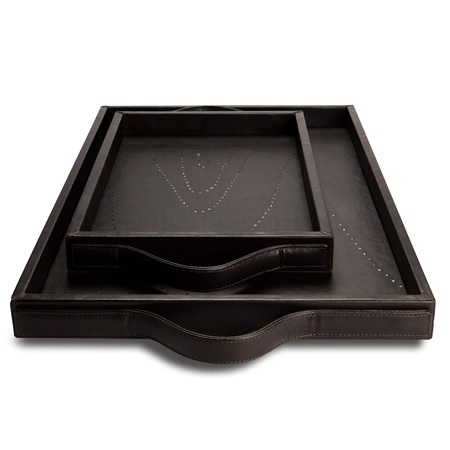
Above: Francois Azambour for GAIA&GINO: Fake Wood collection - crystals with leather. At the end of 2007, SWAROVSKI ELEMENTS introduced Chaton Leather – a new application technique exclusive to the company which integrates Chatons into leather so perfectly that a flat surface results. The French designer Francois Azambourg, who has worked for some of the top leather companies as well as the big names in Italian design, was attracted by its assimilation of two opposing materials – hard, shiny crystal and organic, matte leather. Choosing to design products often made in wood – a desk-top box and a tray – he has instead evoked a wood grain pattern using Chatons. “These are often utilitarian products, so the introduction of something as fine and decorative as this patterned Chaton Leather technique is at odds with the objects. But it opens the door to a whole collection. These were our first steps to see if it worked, which it does,” says Azambourg.
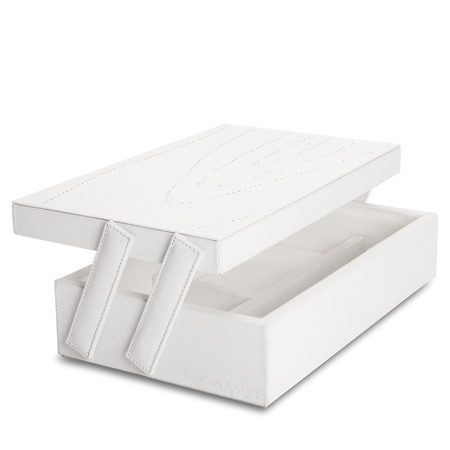
“The quality of leather in Turkey is superb, so it made sense to use this new SWAROVSKI ELEMENTS technique here,” says Gaye Cevikel of GAIA&GINO. “I really wanted to collaborate with Francois as he is a fantastic engineer and problem solver, but then he adds great wit and poetry to his designs. The trays and boxes he has designed for us with Chaton Leather are very elegant. There is nothing like them on the market. The trays are entirely lined in leather but totally functional – no glass is needed to make them useable.”

Above: Sebastian Bergne for GAIA&GINO: Eye collection - crystals with Iznik ceramic.
London-based designer Sebastian Bergne is known for his precise, pared-down design. Inspired by a visit to the Iznik Factory in Istanbul, he turned to ceramics for this project to introduce a range of bowls and vases. Bergne has, however, applied his usual rigour and created pared-down designs incorporating the “Nazar” charm that traditionally protects the owner from the evil eye or bad luck. In this collection, GAIA&GINO used Turkish heritages both in material and concept. The “Iznik quartz ceramics” –a material with a thousand year old tradition- is reinterpreted by Bergne in a very Turkish concept “evil eye” and universalized for the first time in a contemporary design object.
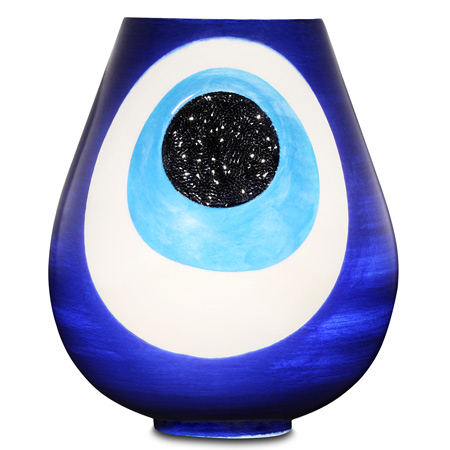
“Iznik work and the Nazar symbol are really important in Turkish culture, so both struck a chord. The eye motif is also slightly surreal when applied to these products. I’ve moved a long way out of my comfort zone here, working with decoration,” says Bergne. “I used a new SWAROVSKI ELEMENTS product called Crystal Rocks (crystals applied to a synthetic carrier material) for the pupil of the eye. It looks and feels organic and rough, like it’s been grown not made. It’s less jewel-like than a single crystal and will, I hope, create a strong focal point.” Bergne was born in Tehran and spent much of his youth in the Middle East – the project represented a welcome return to a visually and sensually rich culture.
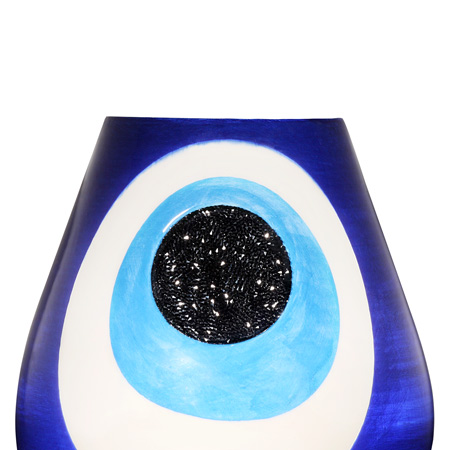
Gaye Cevikel is the founder of GAIA&GINO, the Istanbul design company established in 2004, which works with names including Arik Levy and Jaime Hayon. “Sebastian had been on my wish list for a while – his language is completely consistent with that of GAIA&GINO,” says Cevikel. “The combination of technology with craftsmanship and some storytelling is perfect. Iznik quartz is a unique type of ceramic, made with quartz and fired at very high temperatures and extremely durable (lasting 1000 years). He fell in love with the technique and the colours you could achieve. The result is an extraordinary combination of Turkish history and contemporary design.”
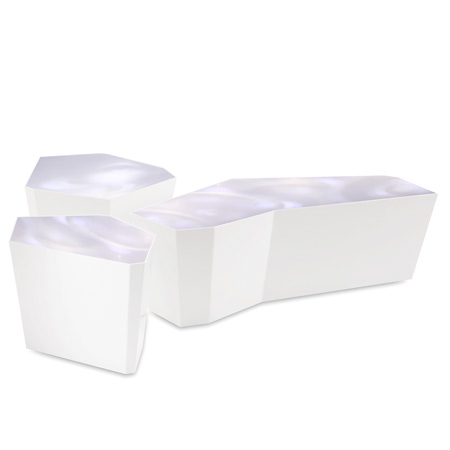
Above: Tomoko Azumi for Lapalma: FLOE tables - crystals with LED lights. Tomoko Azumi had already explored the idea of picking up the reflection of crystals with LED lights when she made tiny paper lanterns for Swarovski’s Wedding Project, which has toured the world since 2008. Now the Japanese-born and educated, London-based designer has grown the concept into furniture, with a set of three tables. Inside the tables – sheet metal caskets topped with translucent glass – light emanates from LEDs and bounces off suspended crystals. “The illuminated tables are already a focal point in a dark room, but there is an added level of interactivity: when you touch them, something happens, the light moves and flickers, shadows play,” says Azumi, who worked with lapalma previously on the very successful LEM stool. “The company is excellent at precision work,” says Azumi, “but the installation of the crystal and the lighting inside the piece is pure innovation.”
Lapalma has been producing fine furniture in northern Italy for over 30 years and now exports 95% of its product, known for its lack of ostentation, all over the world. “Lapalma is not associated with crystals at all,” says head of export, Marco Desiderati. “But then, Swarovski is not usually associated with furniture. I guess we were both interested in new territories and as a result, this project has been a fruitful marriage.” As Desiderati points out, “We really don’t need any more objects these days. But we do need emotion and sensation. For that reason, Tomoko’s tables, which will create a special atmosphere and possess a certain magic, seem right for the times.”
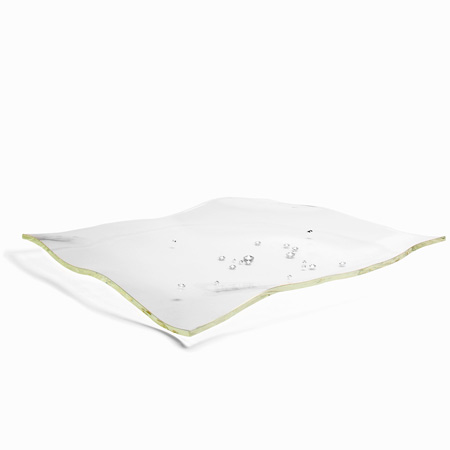
Above: Studio Pei-Zhu for When Objects Work: Lotus Plate - crystals with glass. Since its founding in 2005 by architect Zhu Pei, alongside product designer Wu Tong, Studio Pei-Zhu has emerged as one of China’s leading experimental architecture practices. Based in Beijing, its projects span Digital Beijing, the digital command center of the Beijing Olympics, to commissioned proposals for Guggenheim buildings in Abu Dhabi and Beijing. For SWAROVSKI ELEMENTS at Work, the studio has created the Lotus plate, a design that, like the firm’s architecture, gives time-honored Chinese concepts a cutting-edge, contemporary expression. The Lotus plate features crystals lightly scattered on an undulating, polished-glass surface. “The Chinese name for crystal - shui jing - translates literally as ‘water stone,’” Zhu explains. “Imagine a Chinese garden, and a lotus leaf floating in water after a soft rain. The water droplets evoke scattered reflections of time and light from the crystal’s surface—a peaceful moment full of anticipation.”
When objects work is the Belgian company that specialises in highly refined products designed by architects, including John Pawson and Shigeru Ban. This is their first project with STUDIO PEI-ZHU “It is in completely clear glass sprinkled with crystals, and almost entirely handmade,” says Thomas Ostyn who is head of production for when objects work. “We like to work with people who have a vision and it’s always interesting to see architects translate their ideas into a small object. They are so deeply concerned with proportion and function. This piece is no exception.”
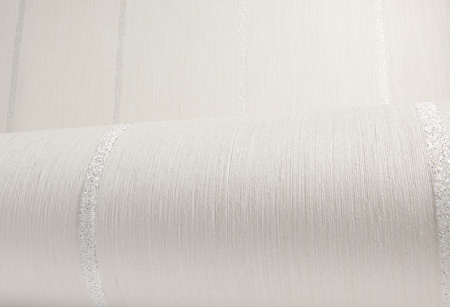
Above: Fanny Aronsen for FANNYARONSEN presented at KVADRAT: Novalin Irrbloss, Perla, Blenda, Spraka - crystal on Fabric. Fanny Aronsen, born in Malmo, Sweden, is a designer and academic, trained in textile design and art history, and often weaving cultural references into her especially elegant work. The tactility of her design is paramount. “My challenge was to absorb the idea of crystals into the spirit of my design, my expression,” says Aronsen. “I love the soft tactile feel of the linen and the hard crystal. It’s astonishing – a completely new procedure.”
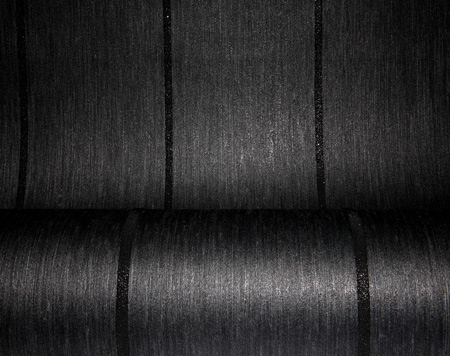
She has produced various fabrics, one using the new technique, flocking with SWAROVSKI ELEMENTS. “That introduces a new three dimensionality,” says Aronsen. “And the brilliance of the crystal is highlighted by the wool.” Another, a work of extreme luxury, introduces hand-embroidery and large size crystal. The collection is completed with Novalin Irrbloss, a brilliant combination of SWAROVSKI ELEMENTS with black and white linen wallpaper.
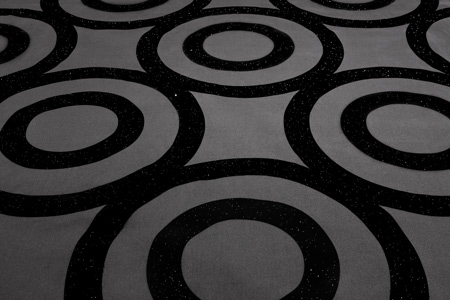
Njusja de Gier is the marketing director of KVADRAT, the highly creative Danish company which produces and distributes Fanny Aronsen textiles. “It is a great opportunity to work with an established company like Swarovski and working with Fanny Aronsen is always a pleasure. She is so talented and a real expert in textile design.
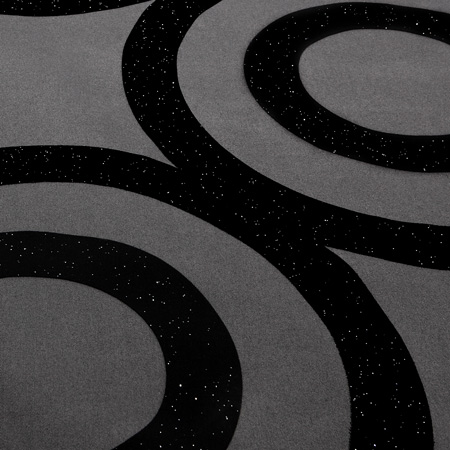
She has created four beautiful textile designs, and a wall covering, which represents a perfect symbiosis between the crystals and the fabric, bring out the best of both. By working with differently shaped crystals, and by using embroidery and different kinds of prints for the fabrics, she created an opulent and elegant collection.” KVADRAT’s managing director, Anders Byriel, adds that Fanny’s contribution shows her unique skill in combining technology, industrial design and art history.”
The information below is from Swarovski:
In a major new initiative from SWAROVSKI ELEMENTS, some of the most exciting names in the design world – including Konstantin Grcic, Nendo, MOROSO, BD Barcelona Design and GAIA&GINO – will be brought together during the Milan Furniture Fair 2010. The exhibition “SWAROVSKI ELEMENTS at Work” shows what happens when 10 leading international designers are united with 9 of the world’s best industrial design producers. The results will be on show exclusively at the Triennale in Milan from 13 to 19 April.
Swarovski has masterminded this unique series of partnerships between designers and manufacturers to discover new and unexpected ways to use crystals in industrial design. In “SWAROVSKI ELEMENTS at Work”, you will find crystals, objects of beauty in their own right, incorporated in furniture and products in unexpected ways to create innovative pieces that will go on to be commercially produced and retailed around the world.
The project has brought together some exceptional international talents and producers. We are delighted, for example, to present Konstantin Grcic’s very first project with ABET LAMINATI and to introduce the important Chinese architects of Studio Pei-Zhu to Milan for the first time.
During visits at Swarovski’s headquarters in Wattens, Austria, designers and manufacturers alike were exposed to the most sophisticated new techniques and processes Swarovski has to offer. Products, from seating to accessories to wall treatments, will include crystal in groundbreaking and subtle combinations with a range of materials including leather, concrete and laminate.
See also:
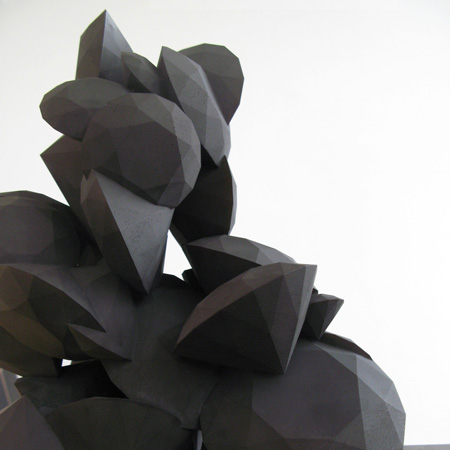 |
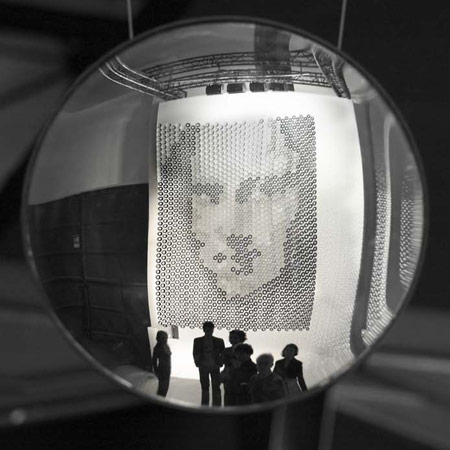 |
our special category |